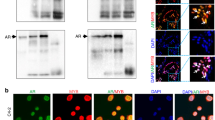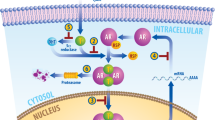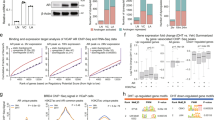Abstract
Prostate tumour growth depends on androgens; hence treatment includes androgen ablation and anti-androgens. Eventually tumours progress and in approximately 30% of patients this is associated with mutation of the androgen receptor. Several receptor variants associated with advanced disease show promiscuous activation by other hormones and anti-androgens. Such loss of specificity could promote receptor activation, hence tumour growth, in the absence of conventional ligands, explaining therapy failure. We aimed to elucidate mechanisms by which alternative ligands promote receptor activation. The three most commonly identified variants in tumours (with amino-acid substitutions H874Y, T877A and T877S) and wild-type receptor showed differences in co-activator recruitment dependent upon ligand and the interaction motif utilized. Co-expression and knockdown of co-activators that bind via leucine or phenylalanine motifs, combined with chromatin immunoprecipitation and quantitative PCR, revealed these preferences extend to co-activator recruitment in vivo and affect receptor activity at the transcriptional level, with subsequent effects on target gene regulation. The findings suggest that mutant receptors, activated by alternative ligands, drive growth via different mechanisms to androgen-activated wild-type receptor. Tumours may hence behave differently dependent upon any androgen receptor mutation present and what ligand is driving growth, as distinct subsets of genes may be regulated.
This is a preview of subscription content, access via your institution
Access options
Subscribe to this journal
Receive 50 print issues and online access
$259.00 per year
only $5.18 per issue
Buy this article
- Purchase on Springer Link
- Instant access to full article PDF
Prices may be subject to local taxes which are calculated during checkout






Similar content being viewed by others
References
Agoulnik I, Vaid A, Bingman WR, Erdeme H, Frolov A, Smith C et al. (2005). Role of SRC-1 in the promotion of prostate cancer cell growth and tumor progression. Cancer Res 65: 7959–7967.
Askew E, Gampe RJ, Stanley T, Faggart J, Wilson E . (2007). Modulation of androgen receptor activation function 2 by testosterone and dihydrotestosterone. J Biol Chem 282: 25801–25816.
Berrevoets CA, Veldscholte J, Mulder E . (1993). Effects of antiandrogens on transformation and transcription activation of wild-type and mutated (LNCaP) androgen receptors. J Steroid Biochem Mol Biol 46: 731–736.
Bevan CL, Hoare S, Claessens F, Heery DM, Parker MG . (1999). The AF1 and AF2 domains of the androgen receptor interact with distinct regions of SRC1. Mol Cell Biol 19: 8383–8396.
Callewaert L, Verrijdt G, Haelens A, Claessens F . (2004). Differential effect of small ubiquitin-like modifier (SUMO)-ylation of the androgen receptor in the control of cooperativity on selective versus canonical response elements. Mol Endocrinol 18: 1438–1449.
Chen C, Okayama H . (1987). High efficiency transformation of mammalian cells by plasmid DNA. Mol Cell Biol 7: 2745–2752.
Chmelar R, Buchanan G, Need EF, Tilley W, Greenberg NM . (2007). Androgen receptor coregulators and their involvement in the development and progression of prostate cancer. Int J Cancer 120: 719–733.
Dubbink HJ, Hersmus R, Verma CS, van der Korput HA, Berrevoets CA, van Tol J et al. (2004). Distinct recognition modes of FXXLF and LXXLL motifs by the androgen receptor. Mol Endocrinol 18: 2132–2150.
Duff J, McEwan IJ . (2005). Mutation of histidine 874 in the androgen receptor ligand-binding domain leads to promiscuous ligand activation and altered p160 coactivator interactions. Mol Endocrinol 19: 2943–2954.
Estebanez-Perpina E, Moore JM, Mar E, Delgado-Rodrigues E, Nguyen P, Baxter JD et al. (2005). The molecular mechanisms of coactivator utilization in ligand-dependent transactivation by the androgen receptor. J Biol Chem 280: 8060–8068.
Fujimoto N, Mizokami A, Harada S, Matsumoto T . (2001). Different expression of androgen receptor coactivators in human prostate. Urology 58: 289–294.
Gamble SC, Chotai D, Odontiadis M, Dart DA, Brooke GN, Powell SM et al. (2006). Prohibitin, a protein downregulated by androgens, represses androgen receptor activity. Oncogene 26: 1757–1768.
Gelmann EP . (2002). Molecular biology of the androgen receptor. J Clin Oncol 20: 3001–3015.
Goktas S, Crawford ED . (1999). Optimal hormonal therapy for advanced prostatic carcinoma. Semin Oncol 26: 162–173.
Gottlieb B, Beitel LK, Wu JH, Trifiro M . (2004). The androgen receptor gene mutations database (ARDB): 2004 update. Hum Mutat 23: 527–533.
Gregory C, Hamil K, Kim D, Hall S, Pretlow T, Mohler J et al. (1998). Androgen receptor expression in androgen-independent prostate cancer is associated with increased expression of androgen-regulated genes. Cancer Res 58: 5718–5724.
Gregory CW, He B, Johnson RT, Ford OH, Mohler JL, French FS et al. (2001). A mechanism for androgen receptor-mediated prostate cancer recurrence after androgen deprivation therapy. Cancer Res 61: 4315–4319.
He B, Kemppainen JA, Wilson EM . (2000). FXXLF and WXXLF sequences mediate the NH2-terminal interaction with the ligand binding domain of the androgen receptor. J Biol Chem 275: 22986–22994.
He B, Lee LW, Minges JT, Wilson EM . (2002). Dependence of selective gene activation on the androgen receptor NH2- and COOH-terminal interaction. J Biol Chem 277: 25631–25639.
Hsu CL, Chen YL, Yeh S, Ting HJ, Hu YC, Lin H et al. (2003). The use of phage display technique for the isolation of androgen receptor interacting peptides with (F/W)XXL(F/W) and FXXLY new signature motifs. J Biol Chem 278: 23691–23698.
Hu Y, Yeh S, Yeh S, Sampson E, Huang J, Li P et al. (2004). Functional domain and motif analyses of androgen receptor coregulator ARA70 and its differential expression in prostate cancer. J Biol Chem 279: 33438–33446.
Hur E, Pfaff SJ, Payne ES, Gron H, Buehrer BM, Fletterick RJ . (2004). Recognition and accommodation at the androgen receptor coactivator binding interface. PLoS Biol 2: E274.
Kalkhoven E, Valentine JE, Heery DM, Parker MG . (1998). Isoforms of steroid receptor co-activator 1 differ in their ability to potentiate transcription by the oestrogen receptor. EMBO J 17: 232–243.
Kang Z, Janne OA, Palvimo JJ . (2004). Coregulator recruitment and histone modifications in transcriptional regulation by the androgen receptor. Mol Endocrinol 18: 2633–2648.
Kazmin D, Prytkova T, Cook CE, Wolfinger R, Chu TM, Beratan D et al. (2006). Linking ligand-induced alterations in androgen receptor structure to differential gene expression: a first step in the rational design of selective androgen receptor modulators. Mol Endocrinol 20: 1201–1217.
Kemppainen JA, Langley E, Wong CI, Bobseine K, Kelce WR, Wilson EM . (1999). Distinguishing androgen receptor agonists and antagonists: distinct mechanisms of activation by medroxyprogesterone acetate and dihydrotestosterone. Mol Endocrinol 13: 440–454.
Li J, Zhang D, Fu J, Huang Z, Wong J . (2007). Structural and functional analysis of androgen receptor in chromatin. Mol Endocrinol; e-pub ahead of print.
Li P, Yu X, Ge K, Melamed J, Roeder RG, Wang Z . (2002). Heterogeneous expression and functions of androgen receptor co-factors in primary prostate cancer. Am J Pathol 161: 1467–1474.
Li X, Wong J, Tsai SY, Tsai MJ, O’Malley BW . (2003). Progesterone and glucocorticoid receptors recruit distinct coactivator complexes and promote distinct patterns of local chromatin modification. Mol Cell Biol 23: 3763–3773.
Linja M, Porkka K, Kang Z, Savinainen K, Janne O, Tammela T et al. (2004). Expression of androgen receptor coregulators in prostate cancer. Clin Cancer Res 10: 1032–1040.
Linja MJ, Savinainen KJ, Saramaki OR, Tammela TL, Vessella RL, Visakorpi T . (2001). Amplification and overexpression of androgen receptor gene in hormone-refractory prostate cancer. Cancer Res 61: 3550–3555.
Lu S, Tsai S, Tsai M . (1997). Regulation of androgen-dependent prostatic cancer cell growth: androgen regulation of CDK2, CDK4, and CKI p16 genes. Cancer Res 57: 4511–4516.
Maki H, Waltering K, Wallen M, Martikainen P, Tammela T, van Weerden W et al. (2006). Screening of genetic and expression alterations of SRC1 gene in prostate cancer. Prostate 66: 1391–1398.
Marcelli M, Ittmann M, Mariani S, Sutherland R, Nigam R, Murthy L et al. (2000). Androgen receptor mutations in prostate cancer. Cancer Res 60: 944–949.
Matias PM, Donner P, Coelho R, Thomaz M, Peixoto C, Macedo S et al. (2000). Structural evidence for ligand specificity in the binding domain of the human androgen receptor. Implications for pathogenic gene mutations. J Biol Chem 275: 26164–26171.
McDonald S, Brive L, Agus DB, Scher HI, Ely KR . (2000). Ligand responsiveness in human prostate cancer: structural analysis of mutant androgen receptors from LNCaP and CWR22 tumors. Cancer Res 60: 2317–2322.
McEwan IJ . (2004). Molecular mechanisms of androgen receptor-mediated gene regulation: structure-function analysis of the AF-1 domain. Endocr Relat Cancer 11: 281–293.
McKenna NJ, Lanz RB, O’Malley BW . (1999). Nuclear receptor coregulators: cellular and molecular biology. Endocrine Rev 20: 321–344.
Mestayer C, Blanchere M, Jaubert F, Dufour B, Mowszowicz I . (2003). Expression of androgen receptor coactivators in normal and cancer prostate tissues and cultured cell lines. Prostate 56: 192–200.
Metivier R, Penot G, Hubner MR, Reid G, Brand H, Kos M et al. (2003). Estrogen receptor-alpha directs ordered, cyclical, and combinatorial recruitment of cofactors on a natural target promoter. Cell 115: 751–763.
Miyamoto H, Yeh S, Wilding G, Chang C . (1998). Promotion of agonist activity of antiandrogens by the androgen receptor coactivator, ARA70, in human prostate cancer DU145 cells. Proc Natl Acad Sci USA 95: 7379–7384.
Nelson PS, Clegg N, Arnold H, Ferguson C, Bonham M, White J et al. (2002). The program of androgen-responsive genes in neoplastic prostate epithelium. Proc Natl Acad Sci USA 99: 11890–11895.
Ozers MS, Marks BD, Gowda K, Kupcho KR, Ervin KM, De Rosier T et al. (2007). The androgen receptor T877A mutant recruits LXXLL and FXXLF peptides differently than wild-type androgen receptor in a time-resolved fluorescence resonance energy transfer assay. Biochemistry 46: 683–695.
Powell SM, Christiaens V, Voulgaraki D, Waxman J, Claessens F, Bevan CL . (2004). Mechanisms of androgen receptor signalling via steroid receptor coactivator-1 in prostate. Endocr Relat Cancer 11: 117–130.
Rogatsky I, Zarember KA, Yamamoto KR . (2001). Factor recruitment and TIF2/GRIP1 corepressor activity at a collagenase-3 response element that mediates regulation by phorbol esters and hormones. EMBO J 20: 6071–6083.
Segal S, Narayanan R, Dalton JT . (2006). Therapeutic potential of the SARMs: revisiting the androgen receptor for drug discovery. Expert Opin Investig Drugs 15: 377–387.
Steketee K, Timmerman L, Ziel-van der Made AC, Doesburg P, Brinkmann AO, Trapman J . (2002). Broadened ligand responsiveness of androgen receptor mutants obtained by random amino acid substitution of H874 and mutation hot spot T877 in prostate cancer. Int J Cancer 100: 309–317.
Taplin ME . (2007). Drug insight: role of the androgen receptor in the development and progression of prostate cancer. Nat Clin Pract Oncol 4: 236–244.
Taplin ME, Bubley GJ, Shuster TD, Frantz ME, Spooner AE, Ogata GK et al. (1995). Mutation of the androgen-receptor gene in metastatic androgen-independent prostate cancer. N Engl J Med 332: 1393–1398.
Ulrix W, Swinnen JV, Heyns W, Verhoeven G . (1999). The differentiation-related gene 1, Drg1, is markedly upregulated by androgens in LNCaP prostatic adenocarcinoma cells. FEBS Lett 455: 23–26.
van de Wijngaart DJ, van Royen ME, Hersmus R, Pike AC, Houtsmuller AB, Jenster G et al. (2006). Novel FXXFF and FXXMF motifs in androgen receptor cofactors mediate high affinity and specific interactions with the ligand-binding domain. J Biol Chem 281: 19407–19416.
Veldscholte J, Berrevoets CA, Mulder E . (1994). Studies on the human prostatic cancer cell line LNCaP. J Steroid Biochem Mol Biol 49: 341–346.
Verrijdt G, Haelens A, Claessens F . (2003). Selective DNA recognition by the androgen receptor as a mechanism for hormone-specific regulation of gene expression. Mol Genet Metab 78: 175–185.
Wurtz J-M, Bourguet W, Renaud J-P, Vivat V, Chambon P, Moras D et al. (1996). A canonical structure for the ligand-binding domain of nuclear receptors. Nat Struct Biol 3: 87–94.
Xu J, Qiu Y, DeMayo FJ, Tsai SY, Tsai M-J, O’Malley BW . (1998). Partial hormone resistance in mice with disruption of the steroid receptor coactivator-1 (SRC-1) gene. Science 279: 1922–1925.
Acknowledgements
We are grateful to Simak Ali and to members of the Androgen Signalling Laboratory for extensive discussion and criticism and for technical help. This study was supported by the Medical Research Council and the Hammersmith Hospitals Trust Research Committee and CB was supported by a grant from the Prostate Cancer Charity.
Author information
Authors and Affiliations
Corresponding author
Additional information
Supplementary Information accompanies the paper on the Oncogene website (http://www.nature.com/onc).
Supplementary information
Rights and permissions
About this article
Cite this article
Brooke, G., Parker, M. & Bevan, C. Mechanisms of androgen receptor activation in advanced prostate cancer: differential co-activator recruitment and gene expression. Oncogene 27, 2941–2950 (2008). https://doi.org/10.1038/sj.onc.1210955
Received:
Accepted:
Published:
Issue Date:
DOI: https://doi.org/10.1038/sj.onc.1210955
Keywords
This article is cited by
-
Androgen receptor mutations modulate activation by 11-oxygenated androgens and glucocorticoids
Prostate Cancer and Prostatic Diseases (2023)
-
Determining direct binders of the Androgen Receptor using a high-throughput Cellular Thermal Shift Assay
Scientific Reports (2018)
-
Androgen- und Östrogenbiosynthesehemmer beim kastrationsresistenten Prostatakarzinom
Der Urologe (2012)
-
Expression and function of nuclear receptor co-activator 4: evidence of a potential role independent of co-activator activity
Cellular and Molecular Life Sciences (2012)
-
The changing therapeutic landscape of castration-resistant prostate cancer
Nature Reviews Clinical Oncology (2011)



